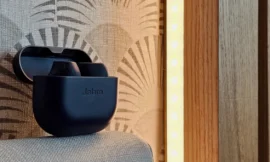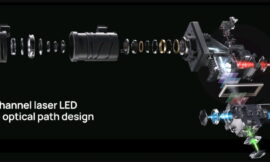Great image quality thanks to full format – and mini: The brand new Sony ZV-E1 should inspire videographers who are looking for an extra small camera.
The Sony ZV-E1 is a top camera for video fans, because it delivers recordings in really top quality and offers a very long recording time and an extremely large number of additional functions. In addition, the very fast and very precise autofocus when filming is a stunner. The ZV-E1 also does well when it comes to photography, but it doesn’t quite keep up with system cameras of the same price when it comes to the level of detail. The photos are less detailed than with cameras with a higher resolution due to the 12-megapixel sensor. On top of that, the ZV-E1 does without a built-in viewfinder.
System cameras have been recording videos for a long time, but models that specialize in filming are still rare, apart from outrageously expensive cine models. One of the few exceptions is Sony’s ZV series. It started very small with the Sony ZV-1 compact camera and was later supplemented with the Sony ZV-E10 system camera and another compact camera, the Sony ZV-1F . A special feature of the series is, in addition to many video functions, the small dimensions of the cameras. The Sony ZV-E1 is now the first full-frame system camera in the series. COMPUTER BILD has already tested the new one and says where the ZV-E1 excels and where it weakens.
4K in really good
The sensor of the Sony ZV-E1 is fully designed for films in 4K (3840×2160 pixels). It starts with the resolution: the sensor has “only” 12 megapixels (resolution 4240×2832 pixels) and is also found in a similar form in the Sony Alpha 7S III system camera and in the smallest model in Sony’s Cine series, the Sony FX3. Advantage of the comparatively low resolution: The individual pixels are larger and thus collect more light in poor lighting conditions. This ensures a higher picture quality for the videos. The picture quality of the ZV-E1 was completely convincing in the test. Very detailed and crisp sharp. In addition, there is better sound quality than most system cameras, because the ZV-E1 has a particularly complex three-capsule microphone, which can be equipped with a windscreen for outdoor recordings (called Dead Cat in technical jargon, see picture below). An external microphone is not absolutely necessary. If you still want to use an external model, you have two options: analogue via the 3.5 mm jack socket or digital via the ZV-1’s accessory shoe. Here, for example, the ECM-B10 from Sony fits. In 4K, the ZV-E1 can also film with 60 frames per second (4K60p) instead of 30 (4K30p). Good for action and fast camera pans – the picture then shakes less. In June 2023, a firmware update should enable recording in 4K with 120 frames per second (4K120p) – this is particularly interesting for slow motion.

You can always rely on the autofocus
If you don’t want to bother with focusing while filming, the Sony ZV-E1 is the right choice, because it comes with Sony’s best autofocus technology. The BIONZ XR image processor is joined by another computing unit that works with artificial intelligence (AI). This additional chip was previously only available in the Sony Alpha 7R V. It ensures very fast and extremely accurate subject recognition. For example, the ZV-E1 not only recognizes faces and eyes like most current system cameras, but also the posture of people. This makes it easier to focus when the subject has their back to the camera or when their face is covered by glasses, a helmet or a hat. In the test, the ZV-E1 was never wrong with videos and the hit rate was also extremely high with photos. Only with focus tracking do you notice that the ZV-E1 is designed for videos. It works very evenly (almost always looks better with videos), but doesn’t quite reach the pace of top professional models like the Canon EOS R3, the Nikon Z9 or the Sony Alpha 1.

Extremely many video functions
The Sony ZV-E1 not only records videos in top quality, it also offers an extremely wide range of video settings. It starts with video formats: In addition to a recording in H.264 (standard format with high compression and simple processing at the same time), a recording in H.265 (particularly high compression, but power-hungry in processing) or in the All-Intra- Format possible – the images are saved individually here. This ensures enormous amounts of data, but also enables particularly precise processing.
Also a matter of course with the ZV-E1: Video recordings with a higher color depth (10 bit and 4:2:2), in log format (enables particularly fine brightness correction during later editing) or in cinema widescreen format 2.35:1 (Cinematic Vlog). There are also many comfort functions: For example, a particularly complex image stabilization that combines the image stabilizer in the camera with digital stabilization to ensure a steady image when taking pictures while walking or running. Or an automatic dimming function that provides more depth of field when a second person comes into the picture. And an automatic zoom function, which always zooms in on the person in the frame, even if they’re moving. Or a double recording that saves a zoomed-in recording on the card in the camera and the original section on a recorder connected via HDMI, such as the Atomos Ninja V+.
If you want to use the many video functions of the ZV-E1, you have to be careful when selecting the memory card: A conventional SD card is sufficient for 4K30p , for 4K60p it should be a fast SD card with UHS-II technology and for a recording in the All-Intra format, a card with V90 (writes permanently with at least 90 megabytes per second) is required.

Very long films
As a video specialist, the Sony ZV-E1 films really long. Most new system cameras now manage longer than 30 minutes, but the ZV-E1 has a particularly long breath. With the first video, however, it was already over after just under 28 minutes in 4K with 30 frames per second (4K30p) – the camera switched off due to heating. However, this was due to the standard settings of the ZV-E1. If you allow a higher temperature when filming in the camera menu, you can film much longer. It is best to switch the option on right away if the ZV-E1 suggests it when you start up the camera. In battery mode, well over two hours were possible in the test. The ZV-E1 was only lukewarm, but not hot. With a power supply via USB-C, the ZV-E1 even lasted thirteen hours when filming in 4K30p. How long the device films in one go depends heavily on the video settings. If you film in 4K with 60 frames per second (4K60p) or a very high data rate, the image processor will sweat a lot more. In 4K60p, for example, the ZV-E1 filmed a maximum of 49 minutes in one go.
Not a photo specialist
Please don’t misunderstand: the Sony ZV-E1 takes great photos. Even in low light, the pictures look really good. But for the same money there’s also the Sony Alpha 7 IV and for a little more there’s the Sony Alpha 7R IV . Thanks to the higher resolution of 33 megapixels (Alpha 7 IV) and 60 megapixels (Alpha 7R IV), its photos are significantly more detailed than the ZV-E1 (12 megapixels) and are therefore suitable for photographers who rarely record videos. the better choice. The ZV-E1 is clearly better than its sister models when it comes to filming.
A real mini case
The Sony ZV-E1 is a true full-frame mini camera. It’s even a bit smaller than the Sony Alpha 7C , the manufacturer’s smallest model to date. The body of the ZV-E1 weighs only 483 grams with battery and memory card , with a light lens like the FE 20mm f1.8 G or the FE PZ 16-35mm f4 G it easily stays under the 1 kg mark. With larger lenses – such as the tested FE 24-105mm f4 G OSS– the ZV-E1 quickly becomes a bit top-heavy. When filming from your hand, you should put your hand under the lens. The price for the mini design of the ZV-E1: There is no space for a flash (only photographers need it) or a viewfinder. And additional threaded holes for a handle on the left side or a carrying handle are reserved for the more expensive Sony FX3 sister model.
Test results Sony ZV-E1






